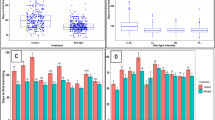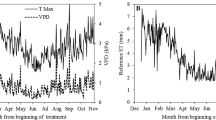Abstract
Appropriate canopy management, including planting density and pruning, and application of fertilizer may increase flowering success and seed and oil yields of Jatropha curcas L. Two field experiments were performed from 2009 to 2011 in Balaka, Malawi, to assess the effect of planting density and pruning regime and single fertilizer application (N, P, and K) on male and female flower number and seed and oil yields of J. curcas. Planting density influenced flower sex ratio and female flower number. Branch pruning treatments did not influence the flower sex ratio but reduced seed and final oil yield by 55 % in the following year. It is claimed that J. curcas can be grown on soils with low nutrient content, but this study revealed that yield was low for non-fertilized trees. We observed higher seed and oil yields at higher N application rates (up to 203 ± 42 % seed and 204 ± 45 % oil yield increase) compared with the non-fertilized control. The study suggests thatcurrently used heavy pruning practice is not recommended for J. curcas cultivation, although it needs further longer term investigation. Applying nitrogen fertilizer is effective in increasing yield.





Similar content being viewed by others
References
Singh KJ, Sooch SS (2004) Comparative study of economics of different models of family size biogas plants for state of Punjab, India. Energy Convers Manag 45:1329–1341
Fairless D (2007) Biofuel: the little shrub that could may be. Nature 449:652–655
Amigun B, Musango JK, Stafford W (2011) Biofuels and sustainability in Africa. Renew Sustain Energy Rev 15:1360–1372
Kabir E, Hussain D, Haque A, Kim KH (2009) Prospects for biodiesel production from Jatropha Curcas L.: a case study of Bangladesh agricultural University farm. Int J Green Energy 6:381–391
Muys B, Norgrove L, Alamirew T, Birech R, Chirinian E, Delelegn Y et al (2014) Integrating mitigation and adaptation into development: the case of Jatropha curcas in sub-Saharan Africa. GCB Bioenergy 6:169–171
Divakara BN, Upadhyaya HD, Wani SP, Gowda CLL (2010) Biology and genetic improvement of Jatropha curcas L.: a review. Appl Energy 87:732–742
Negussie A, Achten WMJ, Verboven HAF, Hermy M, Muys B (2014) Floral display and effects of natural and artificial pollination on fruiting and seed yield of the tropical biofuel crop Jatropha curcas L. GCB Bioenergy 6:210–218
Behera SK, Srivastava P, Tripathi R, Singh JP, Singh N (2010) Evaluation of plant performance of Jatropha curcas L. under different agro-practices for optimizing biomass—a case study. Biomass Bioenergy 34:30–41
Negussie A (2013) Regeneration ecology of Jatropha curcas L. in Africa: implications for its biofuel production and invasiveness. Doctoral thesis, Faculty of Bioscience Engineering, KU Leuven, Belgium. 166 pp
Negussie A, Degerickx J, Norgrove L, Achten WMJ, Hadgu KM, Aynekulu E, Muys B (2015) Effects of accession, spacing and pruning management on in-situ leaf litter decomposition of Jatropha curcas L. in Zambia. Biomass and Bioenergy in press. doi:10.1016/j.biombioe.2015.08.004
Kaushik N, Kumar K, Kumar S, Roy S (2007) Genetic variability and divergence studies in seed traits and oil content of Jatropha (Jatropha curcas L.) accessions. Biomass Bioenergy 31:497–502
Negussie A, Achten WMJ, Verboven HAF et al (2014) Conserving open natural pollination safeguards Jatropha oil yield and oil quality. BioEnergy Res 8:340–349. doi:10.1007/s12155-014-9518-5
Katembo BI, Gray PS (2007) Africa, seed and biofuel. J Multidiscip Res 1:1–6
Negussie A, Achten WMJ, Norgrove L, Hermy M, Muys B (2013) Invasiveness risk of biofuel crops using Jatropha curcas L. as a model species. Biofuels Bioprod Biorefin 7:485–498
Negussie A, Nacro S, Achten WMJ et al (2014) Insufficient evidence of Jatropha curcas L. invasiveness: experimental observations in Burkina Faso, West Africa. BioEnergy Res 8:570–580. doi:10.1007/s12155-014-9544-3
GEXSI (2008) Global Market Study on Jatropha. Final report of The Global Exchange for Social Investment (GEXSI), prepared for the World Wide Fund for Nature (WWF), London/Berlin. 187 pp
Pohl C (2010) Jatropha: money doesn’t grow on trees: ten reasons why Jatropha is neither a profitable nor sustainable investmentwww.foeeurope.org and www.foei.org. Accessed 31 Jan 2013
Jongschaap REE, Kenis M, Ellison C, Rouamba M. and Freyer B (2013) Jatropha growth and oilseed production in Africa. Jatropha Facts Series, Issue 1, ERA-ARD
Achten WMJ, Sharma N, Muys B et al (2014) Opportunities and constraints of promoting new tree crops—lessons learned from Jatropha. Sustainability 6:3213–3231. doi:10.3390/su6063213
Von Maltitz G, Gasparatos A, Fabricius C (2014) The rise, fall and potential resilience benefits of Jatropha in Southern Africa. Sustainability 6:3615–3643. doi:10.3390/su6063615
Makwana V, Shukla P, Robin P (2010) GA application induces alteration in sex ratio and cell death in Jatropha curcas. Plant Growth Regul 6:121–125
Borman GD, Von Maltitz GP, Tiwari S, Scholes MC (2012) Modelling the economic returns to labour for Jatropha cultivation in southern Africa and India at different local fuel prices. Biomass Bioenergy 59:70–83. doi:10.1016/j.biombioe.2012.06.020
Wahl N, Jamnadass R, Baur H, Munster C, Iiyama M (2009) Economic viability of Jatropha curcas L. plantations in Northern Tanzania—assessing farmers prospects via cost-benefit analysis. ICRAF Working Paper No. 97. World Agroforestry Centre, Nairobi
Jongschaap REE, Corré WJ, Bindraban PS, Brandenburg WA (2007) Claims and facts on Jatropha curcas L.: global Jatropha curcas evaluation, breeding and propagation programme. Report no. 158. Plant Research International B.V., Wageningen, 42 pp
Suriharn B, Sanitchon J, Songsri P, Kesmala T (2011) Effects of pruning levels and fertilizer rates on yield of physic nut (Jatropha curcas L.). Asian J Plant Sci 10:52–59
Abdelgadir HA, Jäger AK, Johnson SD, Van Staden J (2010) Influence of plant growth regulators on flowering, fruiting, seed oil content, and oil quality of Jatropha curcas. South African J Bot 7:440–446
Gour VK (2006) Production practices including post-harvest management of Jatropha curcas. In: Singh B, Swaminathan R, Ponraj V (eds) Proceedings of the biodiesel conference toward energy independence focus of Jatropha, June 9-10. Rashtrapati Bhawan, Hyderabad, pp 223–251
Singh S, Lakshsmi Y, Sambariva AR (2006) Effect of nitrogen and phosphorus on oil content and nutrient uptake in rabi castor. Res Crops 7:423–425
Krishna KM, Prabhakar GN, Subrahmanyam MVR (2008) Studies on growth performances of Jatropha (Jatropha curcas L.) under pruning and sources of nutrients. J Res Angrau 36:1–4
Ghosh A, Chikara J, Chaudhary DR (2011) Diminution of economic yield as affected by pruning and chemical manipulation of Jatropha curcas L. Biomass Bioenergy 35:1021–1029
FAO (2010) Jatropha: a smallholder bioenergy crop the potential for pro-poor development Jatropha, vol 8. Integrated Crop Management, Rome
Mohapatra S, Panda PK (2011) Effects of fertilizer application on growth and yield of Jatropha curcas L. in an Aeric Tropaquept of Eastern India. Miner Mater 3:95–100
Joshi V (2005) Cultivation of non traditional oilseed plant- Jatropha curcas for utilization of forest wastelands. Ann For 13:59–62
Rao GR, Korwar GRS, Hanker AK, Ramakrishna YS (2008) Genetic associations, variability and diversity in seed characters, growth, reproductive phenology and yield in Jatropha curcas (L.) accessions. Trees Struct Funct 22:697–709
Environmental Affairs Department of Malawi (EADM) (2006) National biodiversity strategy and action plan. Malawi, Lilongwe
Thierfelder C, Chisui JL, Gama M, Cheesman S, Jere ZD, Trent Bunderson W, Eashd NS, Rusinamhodzi L (2013) Maize-based conservation agriculture systems in Malawi: long-term trends in productivity. Field Crop Res 142:47–57
Houba VJG, Temminghoff EJM, Gaikhorst GA, Van Vark W (2000) Soil analysis procedures using 0.01 M calcium chloride as extraction reagent. Commun Soil Sci Plant Anal 31(9-10):1299–1396
Schnelle MA, Klett JE (1992) Effects of pruning and bark ringing on total nonstructural carbohydrates. J Arboric 18:192–196
Rojas E, Leal F (1997) Effects of pruning and potassium nitrate spray on floral and vegetative bud break of Mango CV. Haden. Acta Hortic 455:522–529
Sun Q, Rost TL, Matthews MA (2006) Pruning-induced Tylose development in stems of current-year shoots of Vitis vinifera (Vitaceae). Am J Bot 93:1567–1576
Wilkie JDA, Sedgley MA, Olesen TC (2010) The timing of pruning affects flushing, flowering and yield of macadamia. Crop Pasture Sci 61:588–600
McFadyen L, Robertson D, Sedgley M, Kristiansen P, Olesen T (2012) Time of pruning affects fruit abscission, stem carbohydrates and yield of macadamia. Funct Plant Biol 39:481–492
Sharma R, Singh R (2006) Pruning intensity modifies canopy microclimate, and influences sex ratio, malformation incidence and development of fruited panicles in “Amrapali” mango (Mangifera indica L.). Sci Hortic 109:118–122
Rajaona AM, Brueck H, Asch F (2011) Effect of pruning history on growth and dry mass partitioning of Jatropha on a plantation site in Madagascar. Biomass Bioenergy 35:4892–4900
Goswami K, Saikia J, Choudhury HK (2011) Economic benefits and costs of Jatropha plantation in North-East India. Agric Econ Res Rev 24:99–108
Ye J, Qu J, Wang C (2013) Improvement of J. curcas oil by genetic transformation. In: Bahadur B, Sujatha M, Carels N (eds) Jatropha challenges for a new energy crop. Genetic Improvement & Biotechnology 2:547–562. doi:10.1007/978-1-4614-4915-7
Trabucco A, Achten WMJ, Bowe C, Aerts R, Van Orshoven J, Norgrove L, Muys B (2010) Global mapping of Jatropha curcas yield based on response of fitness to present and future climate. Glob Chang Biol Bioenergy 2:139–151
Openshaw K (2000) A review of Jatropha curcas: an oil plant of unfulfilled promise. Biomass Bioenergy 19:1–15
Sheil D, Casson A, Meijaard E, Van Nordwijk M, Gaskell J, Sunderland-Groves J, Wertz K, Kanninen M (2009) The impacts and opportunities of oil palm in Southeast Asia: what do we know and what do we need to know? Occasional paper no. 51. CIFOR, Bogor
Wen Y, Tang M, Sun D, Zhu H, Wei J, Chen F, Tang L (2011) Influence of climate factors and soil types on seed weight and oil content of Jatropha curcas in Guangxi, China. Procedia Environ Sci 12:439–444
Joshi G, Shukla A, Shukla A (2011) Synergistic response of auxin and ethylene on physiology of Jatropha curcas L. Braz J Plant Physiol 23:67–77
Agbaje GO, Oloyede FM, Obisesan IO (2012) Effects of NPK fertilizer and season on the flowering and sex expression of pumpkin (Cucurbita pepo Linn.). Int J Agric Sci 2:291–295
Nerson H (2007) Seed production and germinability of Cucurbit Crops. Seed Sci Biotechnol 1–10
Abduljabbar IM, Ghurbat HM (2010) Effect of foliar application of potassium and IAA on growth and yield of two cultivars of squash (Cucurbita pepo L.). J Tikrit Univ Agric Sci 10:222–232
Gupta A, Bharadwaj KV, Lama S, Mathur J (2010) Energy analysis of irrigated Jatropha cultivation for producing biodiesel. Low Carbon Econ 1:54–60
Prueksakorn K, Gheewala SH, Malakul P, Bonnet S (2010) Energy analysis of Jatropha plantation systems for biodiesel production in Thailand. Energy Sustain Dev 14:1–5
Islam AKMA, Yaakob Z, Anuar N (2011) Jatropha: a multipurpose plant with considerable potential for the tropics. Sci Res Essays 6:2597–2605
Yin L, Hu TX, Lui YA, Yao SF, Ma J, Liu WT, He C (2010) Effect of drought on photosynthetic characteristics and growth of Jatropha curcas seedlings under different nitrogen levels. Ying Yong Sheng Tai Xue Bao 2:569–576
Akbarian MM, Modafebehzadi N, Bagheripour MA (2011) Study of fertilizer (NPK) effects on yield and triglycerides in Jatropha (Jatropha curcas). Plant Ecophysiol 2:169–172
Álvarez CL, Marín M, Diez MC, Osorio NW (2012) Molecular identification of microorganisms associated to Rhizosphere of Vanilla and their potential use as biofertilizers. Acta Hort 964:107–114
Acknowledgments
Aklilu Negussie Mekuria worked on this study with a University of Leuven IRO PhD grant. We thank QUINVITA NV for logistic support and the lab analyses. We would like to express our appreciation to Demeter farm, Malawi, for providing accommodation and material supports during our fieldwork. Lindsey Norgrove is supported by the SNSF (Swiss National Science Foundation) through a Marie Heim-Vögtlin research fellowship in Agricultural and Forestry Sciences (grant PMPDP3_145502).
Author information
Authors and Affiliations
Corresponding author
Rights and permissions
About this article
Cite this article
Negussie, A., Achten, W.M.J., Norgrove, L. et al. Initial Effects of Fertilization and Canopy Management on Flowering and Seed and Oil Yields of Jatropha curcas L. in Malawi. Bioenerg. Res. 9, 1231–1240 (2016). https://doi.org/10.1007/s12155-016-9767-6
Published:
Issue Date:
DOI: https://doi.org/10.1007/s12155-016-9767-6




